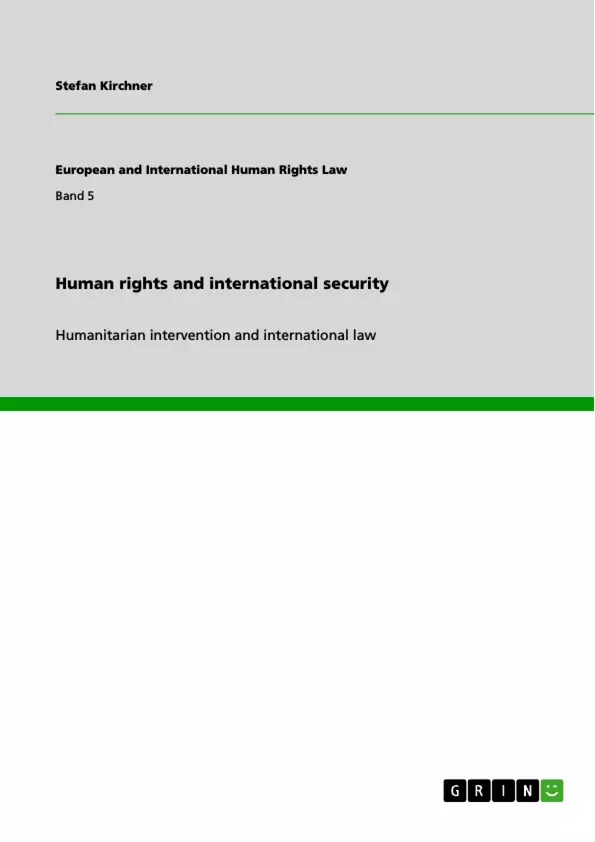With the advent of Human Rights in international law, several core ideas of the traditional system of international law have been challenged, such as the principle of non-interference and state sovereignty, as well as the prohibition of the use of force, especially with the decision that massive human rights violations can form a threat to international peace and security to which the UN Security Council can respond with measures according to Chapter VII of the UN Charter.
While at first sight a change of paradigm in international law, or in any legal system, is not negative per se, the rules which collide with a truly effective and universal protection of HR through international law are the very rules which form the foundation for international peace and security, the primary reason for the existence of international law. While international peace and security require the stability provided by the Westphalian system, they can at the same time be endangered by massive violations of human rights. On the other hand can Human Rights only be enjoyed in times of peace while the Westphalian system can limit the effective and universal enforcement of Human Rights in cases in which the UN Security Council has failed to take action under Chapter VII.
This short book is an attempt at reconciling these needs which are at times direct against each other, at times interlinked ones with a special focus on massive violations of human rights which are not being addressed effectively by the UN Security Council.
To this end, we will look at the Human Rights dimensions of international peace and security outlined above before we come to the core issue of the paper, the legality of the use of force for the protection of Human Rights in cases in which the UN Security Council fails to act, or, in other words, the question of in how far the need for universal respect for human rights can overrun the need for peace, given the links between both factors indicated above.
Inhaltsverzeichnis (Table of Contents)
- Preface
- Table of Contents
- A second Foreword: Everyday Human Rights Violations
- Literature
- Table of Cases
- Other documents......
- Chapter 1 – Introduction:
- Human Rights in Foreign Policy and International Relations.
- I. Human Rights as a concern in international relations
- II. Obstacles on the Road to enduring International Peace and Security and Universal Respect for Human Rights.
- III. Sovereignty and Human Rights.
- Chapter 2 The First Dimension:
- Peace as a prerequisite for the complete enjoyment of all Human Rights
- Massive Violations of Human Rights as a threat to international peace and security
- Chapter 3 - The Second Dimension:
- Chapter 4 - The Third Dimension:
- The use of force against other states for the protection of Human Rights
- I. Introduction: The General Prohibition of the Use of Armed Force
- II. Current possibilities for responses to atrocities....
- 1. UN Security Council: Chapter VII.
- 2. UN General Assembly: Uniting for Peace
- III. The emerging concept of Humanitarian Intervention outside the UN framework - Legal, Moral and Political Considerations
- 1. Introduction
- a. What is Humanitarian Intervention ?
- b. Humanitarian Intervention in the past and today..
- c. Political and Legal Considerations on Humanitarian Intervention de lege lata and de lege ferenda
- 2. Political and moral aspects of Humanitarian Intervention
- 1. Introduction
Zielsetzung und Themenschwerpunkte (Objectives and Key Themes)
This book explores the complex relationship between human rights and international security. It aims to reconcile the need for human rights protection with the need for international peace and stability, focusing on the legality of using force to protect human rights in cases where the UN Security Council fails to act. The book examines the historical and legal frameworks surrounding humanitarian intervention, analyzing the moral, political, and legal considerations involved. Key themes include:- The tension between state sovereignty and human rights protection.
- The role of the UN Security Council in addressing human rights violations.
- The legal and moral justification for humanitarian intervention.
- The historical context of humanitarian intervention and its contemporary challenges.
- The need for a framework for effective and universal human rights enforcement in times of peace and conflict.
Zusammenfassung der Kapitel (Chapter Summaries)
- **Chapter 1: Introduction:** This chapter introduces the book's central theme: the intersection of human rights and international relations. It explores the challenges of achieving enduring international peace and security while ensuring universal respect for human rights, highlighting the inherent tensions between state sovereignty and human rights protection.
- **Chapter 2: The First Dimension:** This chapter examines the importance of peace as a prerequisite for the full enjoyment of human rights. It argues that massive violations of human rights can threaten international peace and security, highlighting the need for effective mechanisms to address such violations.
- **Chapter 3: The Second Dimension:** This chapter will likely focus on the role of international institutions, particularly the UN Security Council, in responding to human rights violations. It will explore the limitations of the current framework and analyze the effectiveness of existing mechanisms for addressing atrocities.
- **Chapter 4: The Third Dimension:** This chapter delves into the controversial issue of humanitarian intervention. It explores the legal, moral, and political considerations surrounding the use of force for human rights protection outside the UN framework. This section will likely discuss historical examples of humanitarian intervention and analyze the evolving legal and moral arguments for and against such interventions.
Schlüsselwörter (Keywords)
This book focuses on the intersection of human rights, international law, and international security. Key terms include: humanitarian intervention, state sovereignty, international peace and security, UN Security Council, Chapter VII of the UN Charter, human rights violations, Westphalian system, de lege lata, de lege ferenda, and the moral and legal justifications for the use of force to protect human rights.- Arbeit zitieren
- Rechtsanwalt Stefan Kirchner (Autor:in), 2008, Human rights and international security, München, GRIN Verlag, https://www.grin.com/document/117000



